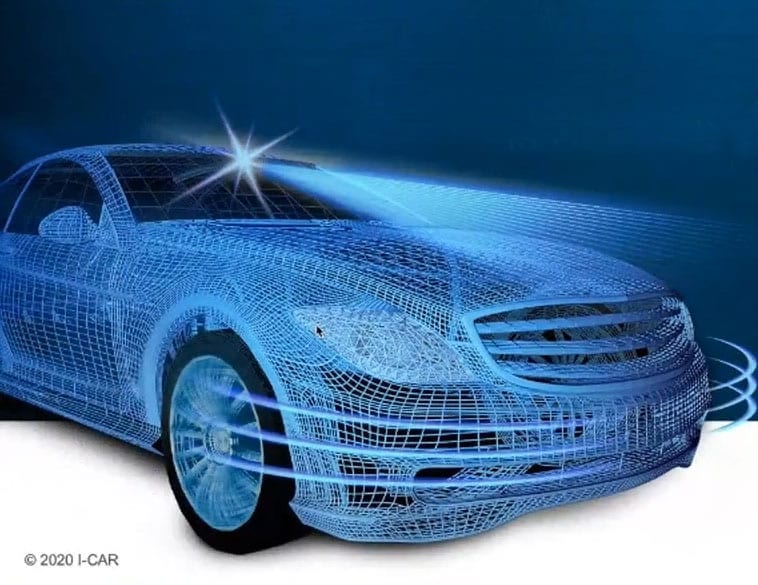Within the last decade, Advanced Driver Assist Systems (ADAS) have proliferated on vehicles.
Whereas once, most only featured anti-lock braking (ABS), we’ve since seen the addition of traction control, stability control, adaptive cruise control, emergency braking, collision warning and collision avoidance to name a few.
Today, when a late model vehicle is involved in a collision, it is imperative that the vehicle is scanned before the repair and that the damage is properly assessed.
As the I-CAR discussion at CCIF Toronto this year—ADAS Is Here: Is Your Shop Prepared? emphasized, everybody working within the shop environment from customer service representatives to estimators and repair technicians must have an understanding of ADAS.
Fundamental understanding
The I-CAR panel discussion featured Bud Center, Director, Technical Products and Curriculum; Dirk Fuchs, Director, Technical Programs and Services; Jeff Poole, Manager, Technician and Subject Matter Expert as well as Scott VanHulle, Manager RTS and OEM Technical Relations.
It centred on the need not only for everybody in the shop to have a fundamental understanding of ADAS but also that technicians who will be performing vehicle repairs know that while the work they are doing may not be directly related to a specific part of the ADAS but it will still likely impact how it operates.
Therefore, knowing which calibrations are needed once repairs are completed is critical.
Bud Center pointed out that when a late-model vehicle with ADAS is damaged following a collision, sensors can easily become misaligned and not able to function properly.
“We have seen things where a car is being driven across the parking lot, even on the collision shop premises and just slams on the brakes because the sensor is pointing in the wrong direction and picks up a pothole or crack in the road surface.” That’s why he said, it is so important for everybody in the shop to have an understanding of ADAS and what it does.
Testing, testing
Jeff Poole noted that when performing repairs on ADAS-equipped vehicles, quality control is key, so it’s important to perform the calibrations and system tests as much as possible before the vehicle leaves the shop.
Bud Center added, that in this day and age, documentation is critical and shops must document what procedures have been performed on the vehicle, as well as static and dynamic calibration testing, plus the test drive and anything else to ensure that once the repairs have been completed the vehicle’s ADAS is functioning as originally designed.
Dirk Fuchs notes that one challenge many shops face today when it comes to ADAS calibrations is having the necessary space and equipment to perform the work. He referred to some illustrations or recommended setups for calibration testing and stressed that adequate shop space and a clean, level floor are essential.
Otherwise, when conducting these calibration tests, the lasers required to perform them might not be able to accurately read the distance or reflections might interfere with the testing process, resulting in inaccurate calibrations.
When it comes to static calibration testing, having adequate distance with which to perform procedures is also becoming increasingly important, especially as more and more OEMs are requiring to make adjustments using an alignment rack at distances of 2.7 metres (8 feet), meaning adequate space around the vehicle is essential to perform these calibrations correctly.
“This is a challenge,” said Fuchs, “as this is the way things are going and a lot of shops are just not prepared for this.”
Outside influences
On the dynamic calibration side, there are also challenges, since the vehicle needs to be in motion to perform these tasks and outside factors such as traffic congestion, weather and road conditions can make it difficult to perform these tests correctly depending on where the shop is located and the time of year the work is being performed.
Ultimately, one of the biggest issues regarding ADAS calibration testing is knowledge and with the technology evolving so rapidly, understanding how it works and gaining the knowledge and insight required to work on these vehicles is critical.
To that end, I-CAR has developed a specific set of learning resources, available at info.icar.com/Scott VanHulle said that for Canadians to access this information, they first must go through icar.ca.
The aim of this is to provide repair technicians with accurate and up-to-date information that’s conveniently located and easy to access helping them not only advance their knowledge and experience with ADAS, but saving them considerable time when actually performing repairs and calibrations in the shop.



